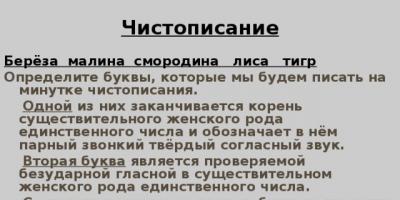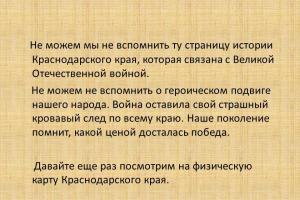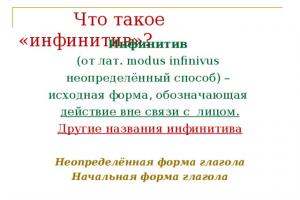From the output of the message source, signals are received that carry information, as well as clock signals used to synchronize the operation of the transmitter and receiver of the transmission system. Information signals have the form of a non-periodic, and clock signals - a periodic sequence of pulses.
To correctly assess the possibility of transmitting such pulses via communication channels, we will determine their spectral composition. A periodic signal in the form of pulses of any shape can be expanded into a Fourier series according to (7).
Signals of various shapes are used for transmission over overhead and cable communication lines. The choice of one form or another depends on the nature of the messages being transmitted, the frequency spectrum of the signals, and the frequency and time parameters of the signals. Signals close in shape to rectangular pulses are widely used in the technology of transmitting discrete messages.
Let's calculate the spectrum, i.e. a set of constant amplitudes and
harmonic components of periodic rectangular pulses (Figure 4,a) with duration and period. Since the signal is an even function of time, then in expression (3) all even harmonic components vanish (  =0), and the odd components take the following values:
=0), and the odd components take the following values:
 (10)
(10)
The constant component is equal to
 (11)
(11)
For a 1:1 signal (telegraph points) Figure 4a:
 ,
, .
(12)
.
(12)
Modules of the amplitudes of the spectral components of a sequence of rectangular pulses with a period  are shown in Fig. 4, b. The abscissa axis shows the main pulse repetition frequency
are shown in Fig. 4, b. The abscissa axis shows the main pulse repetition frequency  () and frequencies of odd harmonic components
() and frequencies of odd harmonic components  ,
, etc. The spectrum envelope changes according to the law.
etc. The spectrum envelope changes according to the law.
As the period increases compared to the pulse duration, the number of harmonic components in the spectral composition of the periodic signal increases. For example, for a signal with a period (Figure 4, c), we find that the constant component is equal to
In the frequency band from zero to frequency there are five harmonic components (Figure 4, d), while there is only one tide.
With a further increase in the pulse repetition period, the number of harmonic components becomes larger and larger. In the extreme case when  the signal becomes a non-periodic function of time, the number of its harmonic components in the frequency band from zero to frequency increases to infinity; they will be located at infinitely close frequency distances; the spectrum of the non-periodic signal becomes continuous.
the signal becomes a non-periodic function of time, the number of its harmonic components in the frequency band from zero to frequency increases to infinity; they will be located at infinitely close frequency distances; the spectrum of the non-periodic signal becomes continuous.
Figure 4
2.4 Spectrum of a single pulse
A single video pulse is specified (Figure 5):
Figure 5
The Fourier series method allows for a deep and fruitful generalization, which makes it possible to obtain the spectral characteristics of non-periodic signals. To do this, let us mentally supplement a single pulse with the same pulses, periodically following after a certain time interval, and obtain the previously studied periodic sequence:
Let's imagine a single pulse as a sum of periodic pulses with a large period.
 ,
(14)
,
(14)
where are integers.
For periodic oscillation
 .
(15)
.
(15)
In order to return to a single impulse, let us direct the repetition period to infinity: . In this case, it is obvious:
 ,
(16)
,
(16)
Let's denote
 .
(17)
.
(17)
The quantity is the spectral characteristic (function) of a single pulse (direct Fourier transform). It depends only on the temporal description of the pulse and in general is complex:
, (18) where  ; (19)
; (19)
 ; (20)
; (20)
 ,
,
Where  - module of the spectral function (amplitude-frequency response of the pulse);
- module of the spectral function (amplitude-frequency response of the pulse);
 - phase angle, phase-frequency characteristic of the pulse.
- phase angle, phase-frequency characteristic of the pulse.
Let us find for a single pulse using formula (8), using the spectral function:
 .
.
If , we get:

 .
(21)
.
(21)
The resulting expression is called the inverse Fourier transform.
The Fourier integral defines momentum as an infinite sum of infinitesimal harmonic components located at all frequencies.
On this basis, they speak of a continuous (solid) spectrum possessed by a single pulse.
The total pulse energy (the energy released at the active resistance Ohm) is equal to
 (22)
(22)
Changing the order of integration, we obtain
![]() .
.
The internal integral is the spectral function of momentum taken with the argument -, i.e. is a complex conjugate quantity: ![]()
Hence
Squared modulus (the product of two conjugate complex numbers is equal to the squared modulus).
In this case, it is conventionally said that the pulse spectrum is two-sided, i.e. located in the frequency band from to.
The given relationship (23), which establishes the connection between the pulse energy (at a resistance of 1 Ohm) and the modulus of its spectral function, is known as Parseval’s equality.
It states that the energy contained in a pulse is equal to the sum of the energies of all components of its spectrum. Parseval's equality characterizes an important property of signals. If some selective system transmits only part of the signal spectrum, weakening its other components, this means that part of the signal energy is lost.
Since the square of the modulus is an even function of the integration variable, then by doubling the value of the integral, one can introduce integration in the range from 0 to:
 .
(24)
.
(24)
In this case, they say that the pulse spectrum is located in the frequency band from 0 to and is called one-sided.
The integrand in (23) is called the energy spectrum (spectral energy density) of the pulse
It characterizes the distribution of energy by frequency, and its value at frequency is equal to the pulse energy per frequency band equal to 1 Hz. Consequently, the pulse energy is the result of integrating the signal’s energy spectrum over the entire frequency range. In other words, the energy is equal to the area enclosed between the curve depicting the signal’s energy spectrum and the abscissa axis.
To estimate the energy distribution over the spectrum, use the relative integral energy distribution function (energy characteristic)
 ,
(25)
,
(25)
Where  - pulse energy in a given frequency band from 0 to, which characterizes the fraction of pulse energy concentrated in the frequency range from 0 to.
- pulse energy in a given frequency band from 0 to, which characterizes the fraction of pulse energy concentrated in the frequency range from 0 to.
For single pulses of various shapes, the following laws hold true:

Spectral analysis of periodic signals
As is known, any signal S(t), described by a periodic function of time that satisfies the Dirichlet conditions (models of real signals satisfy them), can be represented as a sum of harmonic oscillations, called a Fourier series:
where is the average value of the signal over the period or the constant component of the signal;

Fourier series coefficients;
Fundamental frequency (first harmonic frequency); n=1,2,3,…
The set of values An and n (or when expanded in sinusoidal functions n) is called the spectrum of a periodic function. The harmonic amplitudes An characterize the amplitude spectrum, and the initial phases n (or "n) characterize the phase spectrum.
Thus, the spectrum of a periodic signal is represented as a constant component and an infinite number of harmonic oscillations (sine or cosine) with corresponding amplitudes and initial phases. All harmonic frequencies are multiples of the fundamental frequency. This means that if a periodic signal follows a frequency of, for example, 1 kHz, then its spectrum can only contain frequencies of 0 kHz, 1 kHz, 2 kHz, etc. The spectrum of such a periodic signal cannot contain, for example, frequencies of 1.5 kHz or 1.2 kHz.
In Fig. 1. The amplitude and phase spectra of a certain periodic signal are shown. Each harmonic component is depicted as vertical segments, the lengths of which (on some scale) are equal to its amplitude and phase. As you can see, the spectrum of a periodic signal is discrete or, as they say, lined.
In order to simplify calculations, instead of the trigonometric form of writing the Fourier series, they often use a complex form of writing it, the coefficients of which combine the coefficients An and n:

The set of complex amplitudes n is called the complex spectrum of a periodic signal.
The calculation of signal spectra in the complex domain is much simpler, since there is no need to consider separately the coefficients and the trigonometric form of writing the Fourier series.
Spectrum of a periodic sequence of rectangular pulses
Before considering the spectrum of a periodic sequence of rectangular pulses, let us consider the parameters of these pulses.
The parameters of a single pulse are amplitude, pulse duration, rise time, fall duration, and flat top fall (cleavage).
The pulse amplitude Um is measured in volts.
Pulse duration is measured at the base, at levels of 0.1Um or 0.5Um. In the latter case, the pulse duration is called active. The pulse duration is measured in units of time.
The duration of the front tf and fall tс is measured either at the level 0 - Um, or at the level (0.1-0.9) Um. In the latter case, the duration of the front and decline is called active.
Flat top cleavage is characterized by cleavage coefficient? = ?u/Um,
where?u is the chip value; Um - pulse amplitude.
The parameters of the pulse series are the repetition period T, repetition frequency f, duty cycle Q, duty cycle, average voltage values Uav and average power value Pav.
Repetition period T = ti +tp, where T is the period, ti is the pulse duration, tp is the pause duration. T, tи, and tп are measured in units of time.
The repetition frequency f = 1/T is measured in hertz, etc.
The duty cycle Q = T/ti is a dimensionless quantity.
Filling factor = ti/T is a dimensionless quantity.
Average voltage

Let's move on to considering the amplitude and phase spectra of the signal in the form of a periodic sequence of rectangular pulses with duration and amplitude Um, following with period T (Fig. 2).

Let us consider the case when the middle of the pulse is the beginning of the time count. Then the signal over the period is described by the expression

Complex amplitudes of harmonic components.
The function is sign-alternating and changes its sign to the opposite when the argument n1 changes by the amount?



where k is the serial number of the interval on the frequency scale, counted from zero frequency.
Thus, the harmonic amplitudes, including the DC component, are determined by the expression:

and the phases - by the expression =1, 2,3,...
The function characterizes the change in the amplitude spectrum of the signal depending on frequency. It vanishes for values of its argument that are multiples. It follows that harmonics with number n = , where = 1,2,3,... will have zero amplitudes, i.e. absent from the spectrum.
As you know, the ratio is called the duty cycle of the pulse sequence. Thus, in the spectrum of the sequence under consideration there will be no harmonics whose numbers are multiples of the duty cycle.
If the beginning of the time count is associated with the beginning of the pulse, then the amplitude spectrum will remain unchanged, and the phases of the harmonics, in accordance with the property of the Fourier transform, will receive an additional phase shift nп1ф/2. As a result
Expressions for the trigonometric form of recording the Fourier series when counting time from the middle and beginning of the pulse, respectively, have the form:


In Fig. 3. The amplitude and phase spectra of the considered sequence of rectangular pulses with a duty cycle of two are shown.
The phase spectra are shown respectively when counting time from the middle and beginning of the pulse. The dotted lines in the amplitude spectra characterize the behavior of the modulus of the spectral density of a single pulse.
The expression for the values of the amplitudes and phases of harmonics can be easily obtained in a form convenient for calculations. So, when counting time from the middle of the pulse for a duty cycle equal to two, we have
Literature: [L.1], p. 40
As an example, we give the Fourier series expansion of a periodic sequence of rectangular pulses with amplitude, duration and repetition period, symmetrical about zero, i.e.
 , (2.10)
, (2.10)
Here 
Expanding such a signal into a Fourier series gives
 , (2.11)
, (2.11)
where is the duty cycle.
To simplify the notation, you can enter the notation
 , (2.12)
, (2.12)
Then (2.11) will be written as follows
 , (2.13)
, (2.13)
In Fig. 2.3 shows a sequence of rectangular pulses. The spectrum of the sequence, as well as any other periodic signal, is discrete (line) in nature.
The spectrum envelope (Fig. 2.3, b) is proportional  . The distance along the frequency axis between two adjacent spectrum components is , and between two zero values (the width of the spectrum lobe) is . The number of harmonic components within one lobe, including the zero value on the right in the figure, is , where the sign means rounding to the nearest integer, less (if the duty cycle is a fractional number), or (if the duty cycle is an integer value). As the period increases, the fundamental frequency
. The distance along the frequency axis between two adjacent spectrum components is , and between two zero values (the width of the spectrum lobe) is . The number of harmonic components within one lobe, including the zero value on the right in the figure, is , where the sign means rounding to the nearest integer, less (if the duty cycle is a fractional number), or (if the duty cycle is an integer value). As the period increases, the fundamental frequency  decreases, the spectral components in the diagram come closer together, the amplitudes of the harmonics also decrease. In this case, the shape of the envelope is preserved.
decreases, the spectral components in the diagram come closer together, the amplitudes of the harmonics also decrease. In this case, the shape of the envelope is preserved.




When solving practical problems of spectral analysis, cyclic frequencies are used instead of angular frequencies  , measured in Hertz. Obviously, the distance between adjacent harmonics on the diagram will be , and the width of one spectrum lobe will be . These values are presented in parentheses in the chart.
, measured in Hertz. Obviously, the distance between adjacent harmonics on the diagram will be , and the width of one spectrum lobe will be . These values are presented in parentheses in the chart.
In practical radio engineering, in most cases, instead of the spectral representation (Fig. 2.3, b), spectral diagrams of the amplitude and phase spectra are used. The amplitude spectrum of a sequence of rectangular pulses is shown in Fig. 2.3, c.
Obviously, the envelope of the amplitude spectrum is proportional  .
.
As for the phase spectrum (Fig. 2.3, d), it is believed that the initial phases of the harmonic components change abruptly by the amount -π when the sign of the envelope changes sinc kπ/q. The initial phases of the harmonics of the first lobe are assumed to be zero. Then the initial phases of the harmonics of the second lobe will be φ = -π , third petal φ = -2π etc.
Let's consider another Fourier series representation of the signal. To do this, we use Euler’s formula
 .
.
In accordance with this formula, the kth component (2.9) of the signal expansion into a Fourier series can be represented as follows
 ;
;  . (2.15)
. (2.15)
Here the quantities and are complex and represent the complex amplitudes of the spectrum components. Then the series
Fourier (2.8) taking into account (2.14) will take the following form
 , (2.16)
, (2.16)
 , (2.17)
, (2.17)
It is easy to verify that expansion (2.16) is carried out in terms of the basis functions  , which are also orthogonal on the interval
, which are also orthogonal on the interval  , i.e.
, i.e.

Expression (2.16) is complex form Fourier series, which extends to negative frequencies. Quantities and  , where denotes the complex conjugate of a quantity, are called complex amplitudes spectrum Because is a complex quantity, it follows from (2.15) that
, where denotes the complex conjugate of a quantity, are called complex amplitudes spectrum Because is a complex quantity, it follows from (2.15) that
 And
And  .
.
Then the totality constitutes the amplitude spectrum, and the totality constitutes the phase spectrum of the signal.

In Fig. Figure 2.4 shows a spectral diagram of the spectrum of the sequence of rectangular pulses discussed above, represented by a complex Fourier series

The spectrum also has a line character, but unlike the previously considered spectra, it is determined both in the region of positive and in the region of negative frequencies. Since is an even function of the argument, the spectral diagram is symmetrical about zero.
Based on (2.15), we can establish a correspondence between the coefficients and expansion (2.3). Because
 And
And  ,
,
then as a result we get
 . (2.18)
. (2.18)
Expressions (2.5) and (2.18) allow you to find the values in practical calculations.
Let us give a geometric interpretation of the complex form of the Fourier series. Let us select the kth component of the signal spectrum. In complex form, the kth component is described by the formula
where and are determined by expressions (2.15).
In the complex plane, each of the terms in (2.19) is represented as vectors of length  , rotated at an angle and relative to the real axis and rotating in opposite directions with frequency (Fig. 2.5).
, rotated at an angle and relative to the real axis and rotating in opposite directions with frequency (Fig. 2.5).
Obviously, the sum of these vectors gives a vector located on the real axis whose length is . But this vector corresponds to the harmonic component


As for the projections of vectors onto the imaginary axis, these projections have equal lengths, but opposite directions and add up to zero. This means that signals presented in complex form (2.16) are actually real signals. In other words, the complex form of the Fourier series is mathematical an abstraction that is very convenient for solving a number of problems of spectral analysis. Therefore, sometimes the spectrum defined by the trigonometric Fourier series is called physical spectrum, and the complex form of the Fourier series is mathematical spectrum.
And in conclusion, we will consider the issue of energy and power distribution in the spectrum of a periodic signal. To do this, we use Parseval’s equality (1.42). When the signal is expanded into a trigonometric Fourier series, expression (1.42) takes the form
 .
.
DC energy
 ,
,
and the energy of the kth harmonic
 .
.
Then the signal energy
 . (2.20)
. (2.20)
Because average signal power
 ,
,
then taking into account (2.18)
 . (2.21)
. (2.21)
When the signal is expanded into a complex Fourier series, expression (1.42) takes the form
 ,
,
Where  - energy of the kth harmonic.
- energy of the kth harmonic.
The signal energy in this case
 ,
,
and its average power
 .
.
From the above expressions it follows that the energy or average power of the k-th spectral component of the mathematical spectrum is half as much as the energy or power of the corresponding spectral component of the physical spectrum. This is due to the fact that the physical spectrum is distributed equally between the mathematical spectrum.
| -τ and /2 |
| τ and /2 |
| T |
| t |
| U 0 |
| S(t) |
Task No. 1, group RI – 210701
In this expression
| |
sinc function as shown in Fig. 2.6, reaches a maximum (unity) at y = 0 and tends to zero at at® ±¥, oscillating with a gradually decreasing amplitude. It passes through zero at points at= ±1, ±2, …. In Fig. 2.7, A as a function of the ratio p/t 0 shows the amplitude spectrum of the pulse sequence | with n|, and in Fig. 2.7, b the phase spectrum q is shown n. It should be noted that the positive and negative frequencies of a two-way spectrum are a useful way of expressing the spectrum mathematically; It is obvious that in real conditions only positive frequencies can be reproduced.
Attitude
An ideal periodic pulse train includes all harmonics that are multiples of the natural frequency. In communications systems, it is often assumed that a significant portion of the power or energy of a narrowband signal occurs at frequencies from zero to the first zero of the amplitude spectrum (Fig. 2.7, A). Thus, as a measure bandwidth pulse sequence, the value 1/ is often used T(Where T - pulse duration). Note that the bandwidth is inversely proportional to the pulse duration; The shorter the pulses, the wider the band associated with them. Note also that the distance between the spectral lines D f= 1/T 0 is inversely proportional to the pulse period; As the period increases, the lines are located closer to each other.
Table 2.1. Fourier images
| x(t) | X(f) |
| d( t) | |
| d( f) | |
| cos 2 p f 0 t | /2 |
| sin 2 p f 0 t | /2 |
| d( t - t 0) | |
| d( f - f 0) | |
| , a>0 | |
 | |
| | |
| exp(- at)u(t), a>0 | |
| rect( t/ T) | T sinc fT |
| W sinc Wt | rect( f / W) |
 |
 sinc x =
sinc x =
Table 2.2 Properties of the Fourier transform f)
Let us consider a periodic sequence of rectangular pulses with a period T, pulse duration t u and a maximum value. Let us find the series expansion of such a signal by choosing the origin of coordinates, as shown in Fig. 15. In this case, the function is symmetrical about the ordinate axis, i.e. all coefficients of sinusoidal components = 0, and only the coefficients need to be calculated.

constant component
 (2.28)
(2.28)
The constant component is the average value over the period, i.e. is the area of the pulse divided by the entire period, i.e. ![]() , i.e. the same thing that happened with a strict formal calculation (2.28).
, i.e. the same thing that happened with a strict formal calculation (2.28).
Let us remember that the frequency of the first harmonic is ¦ 1 = , where T is the period of the rectangular signal. Distance between harmonics D¦=¦ 1. If the harmonic number n turns out to be such that the argument of the sine is , then the amplitude of this harmonic goes to zero for the first time. This condition is satisfied when . The harmonic number at which its amplitude vanishes for the first time is called "first zero" and denote it with the letter N, emphasizing the special properties of this harmonic:
On the other hand, the duty cycle S of pulses is the ratio of the period T to the pulse duration t u , i.e. . Therefore, the “first zero” is numerically equal to the duty cycle of the pulse N=S. Since the sine goes to zero for all values of the argument that are multiples of p, the amplitudes of all harmonics with numbers that are multiples of the number of the “first zero” also go to zero. That is, at , where k– any integer. So, for example, from (2.22) and (2.23) it follows that the spectrum of rectangular pulses with a duty cycle of 2 consists only of odd harmonics. Because the S=2, then N=2, i.e. the amplitude of the second harmonic goes to zero for the first time - this is the “first zero”. But then the amplitudes of all other harmonics with numbers divisible by 2, i.e. all even ones must also go to zero. With duty cycle S=3, zero amplitudes will be at 3, 6, 9, 12, ... harmonics.
With increasing duty cycle, the “first zero” shifts to the region of harmonics with higher numbers and, consequently, the rate of decrease in harmonic amplitudes decreases. Simple calculation of the amplitude of the first harmonic at Um=100V for duty cycle S=2, U m 1=63.7V, at S=5, U m 1=37.4V and at S=10, U m 1=19.7V, i.e. As the duty cycle increases, the amplitude of the first harmonic decreases sharply. If we find the amplitude ratio, for example, of the 5th harmonic U m 5 to the amplitude of the first harmonic U m 1, then for S=2, U m 5/U m 1=0.2, and for S=10, U m 5 / U m 1 = 0.9, i.e. the rate of attenuation of higher harmonics decreases with increasing duty cycle.
Thus, with increasing duty cycle, the spectrum of a sequence of rectangular pulses becomes more uniform.








